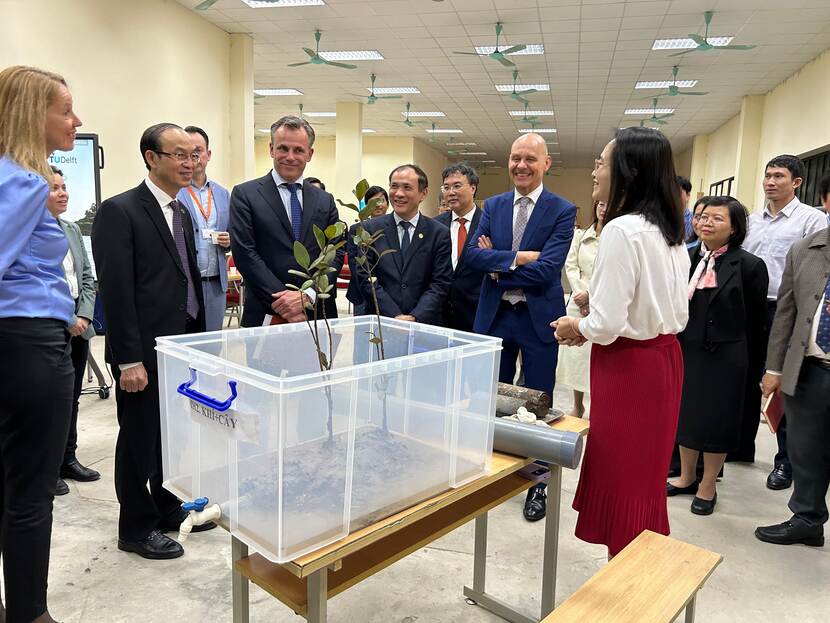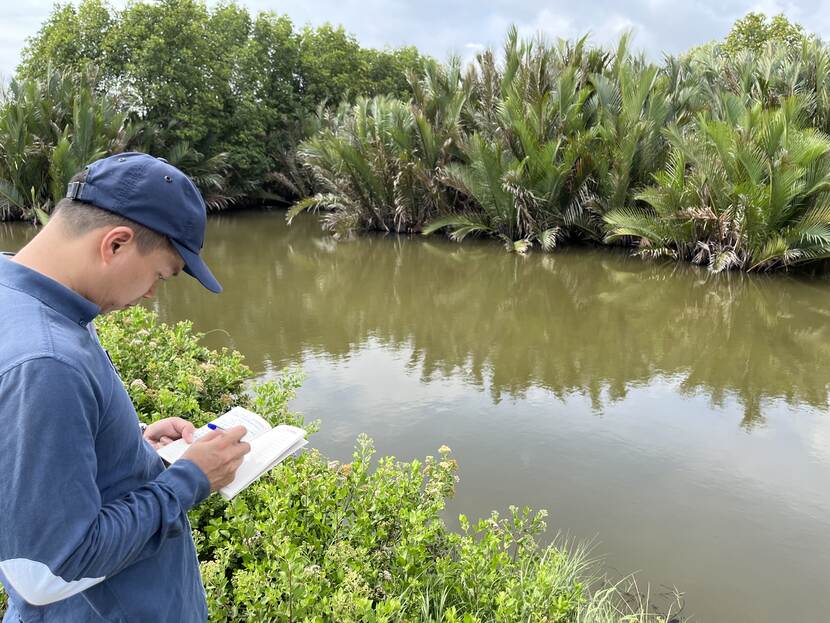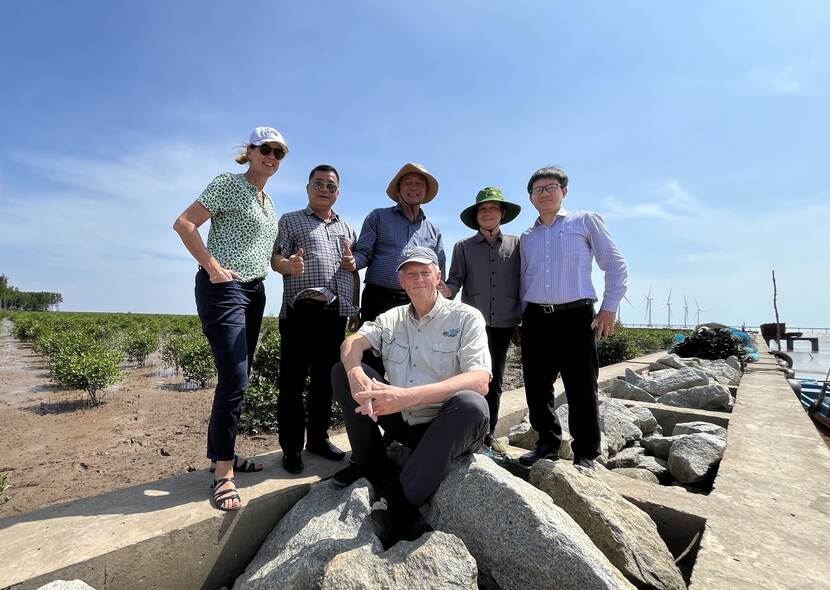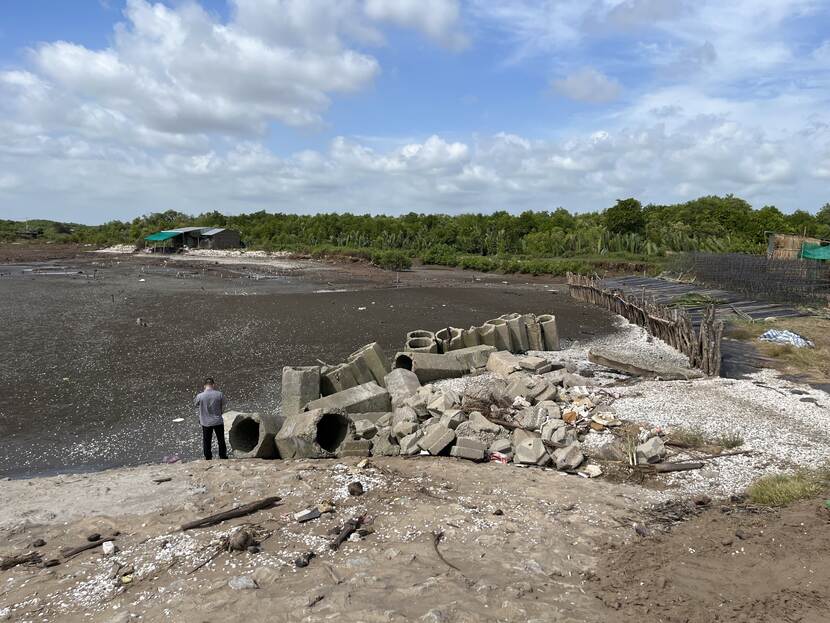Mangrove Living Lab the result of ‘flourishing partnership’ between Vietnam and the Netherlands
Weblogs
Vietnam and the Netherlands are working jointly to restore the mangrove forests that play a key role in preventing coastal erosion in Vietnam’s river deltas. In the newly established Mangrove Living Lab, researchers are testing new ideas aimed at restoring the country’s mangrove forests. ‘Mangroves are often a better and cheaper form of coastal protection, but they don’t give people the same sense of security as concrete dikes.’

Vietnam once had around 400,000 square kilometres of mangrove forests, but 60 to 80% of them have been lost as a result of deforestation. As well as playing a role in coastal protection and nature conservation, mangroves also provide livelihoods, food and fuel for Vietnam’s growing population. Around 20 million people live in the Mekong Delta, Vietnam’s biggest river delta.
Planting young mangroves is one solution, but for new forests to thrive the conditions must be ideal. The new Mangrove Living Lab, which grew out of a partnership between Thuyloi University in Hanoi and Delft University of Technology, will work on this goal in the coming years. Last week the Dutch Minister of Infrastructure and Water Management, Mark Harbers, was given a tour of the lab during his economic mission to Vietnam.
The lab, located in the Mekong Delta, will enable researchers to boost their knowledge by means of in-field studies, long-term monitoring and research experiments. It will also collate various lessons learned and potential nature-based coastal protection solutions and present them in Vietnam.
Long-standing partners
The idea for setting up the Mangrove Living Lab in Vietnam arose during a visit to Delft University of Technology’s Green Village, says Le Hai Trung, associate professor hydraulic engineering, on the phone from Hanoi. The Green Village is a field lab where researchers are testing a wide range of technologies aimed at safeguarding the liveability of urban environments in the face of climate change and the more extreme weather it is causing. Trung is proud of the fact that a similar kind of living lab has now been set up in Vietnam. ‘The first time I saw the Green Village in Delft, I was so inspired,’ he says. ‘I immediately knew that we had to have something like it in Vietnam.’
Thuyloi University and Delft University of Technology are long-standing partners. The first students from Vietnam came to study in Delft 30 years ago, and these days Dutch students from Delft regularly travel to Vietnam to do internships or conduct research. Le Hai Trung himself obtained his PhD in coastal engineering in Delft, before returning to Vietnam to put what he’d learned into practice.

An equal partnership
The Mangrove Living Lab is a good example of the flourishing partnership that our countries have established in the area of water management and coastal protection. ‘An incredible success story,’ is how project leader and Director of the Green Village Marjan Kreijns describes it. ‘What started with sharing Dutch knowledge of delta management has evolved into an equal partnership. We learn from our Vietnamese partners and they learn from us.’
Mangroves are a crucial group of tree species in Vietnam. They trap sediment, can tolerate both saltwater and fresh water, and thrive when their roots are submerged for part of the year. What’s more, they absorb five times more carbon dioxide than a ‘regular’ forest. Unfortunately, Vietnam’s mangroves have suffered severe deforestation and damage owing to environmental pollution and population growth. In the 1990s Vietnam began working to restore the forests, in part to see if the mangroves could help the country cope with the rising sea level.

The Mangrove Living Lab’s goal is to find out what conditions newly planted trees will thrive in. Researchers and students from a wide range of disciplines are working together to this end. ‘We have engineers and ecologists, as well as sociologists, artists and economists,’ says Le Hai Trung. ‘It’s important that we consider every aspect of the mangrove.’
This broad approach is essential to the successful planting of new mangrove forests. ‘Randomly planting new trees is pointless,’ says Marjan Kreijns. ‘You have to look at all the natural circumstances: ensuring sufficient fresh water and healthy soil conditions is important, but there are also important sociological aspects to consider, like local community engagement.’
‘Planting new mangrove forests without public support is pointless’
Expensive concrete dikes
Above all, mangroves are a powerful weapon in the battle against coastal erosion, as the trees enhance sediment deposition. Coastal protection using mangroves is cheaper and more sustainable than solutions like concrete dikes. Yet Vietnam often opts for these kinds of dikes, even though they aren’t always a success. After a storm hit Vietnam just a few months ago, Marjan Kreijns watched as an expensive concrete dike broke apart and washed away. ‘Concrete dikes give people a greater sense of security than mangrove forests,’ she says. ‘So there’s another task here for the Living Lab. Researchers need to convince politicians and the local community that mangrove forests offer superior coastal protection. The public need to truly embrace these forests, or the whole project will fail.’
Le Hai Trung agrees. He is keen to perform studies in local communities on how knowledge of mangrove forests can best be transferred. ‘If knowledge and stewardship of mangroves can be passed from generation to generation, these forests will very likely have a better chance of recovering and thriving. There’s a great deal we still need to learn in this regard. We’re now designing methods for observing and monitoring the characteristics of mangrove forests, and for inviting communities to take part in our research.’

Mekong Delta Plan
The Mangrove Living Lab is part of a larger partnership between the Netherlands and Vietnam. In 2010 the countries’ prime ministers signed a strategic partnership arrangement on climate adaptation and water management. As part of that partnership, in 2022 Vietnam signed up to the International Panel for Deltas and Coastal Areas (IPDC), a coalition initiated by the Netherlands, whose members include numerous other countries and islands. The aim of the IPDC is to use planning and investment to help countries adapt more effectively to climate change.
Over the next few years, tens of millions of euros will be invested in mangrove restoration in Vietnam
As part of the implementation of the Mekong Delta Plan, over the next few years tens of millions of euros will be invested in mangrove restoration. ‘In the preliminary phase the Netherlands has invested €200,000,’ says Sander Carpaij, Delta Coordinator for Vietnam at the Ministry of Infrastructure and Water Management. ‘It’s a relatively small sum, which we mainly want to use to determine what solutions have the best chance of success when it comes to the larger investment in mangrove forest restoration. We need an approach that takes account of specific local conditions and also considers inland mangroves along the rivers and as part of aquaculture systems.'
Around the world, a lot of mangroves are being planted for coastal protection, but unfortunately they’re being planted in the wrong places, or the planters aren’t restoring the right conditions before they start planting, which means the new trees don’t survive. Carpaij: 'So it’s crucial for the overall process that the restoration of existing mangrove forests is done properly.’